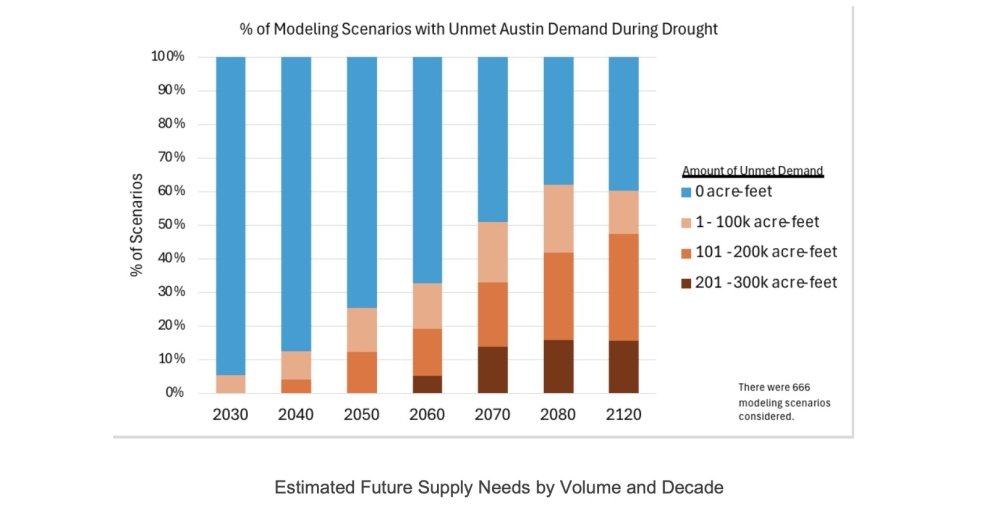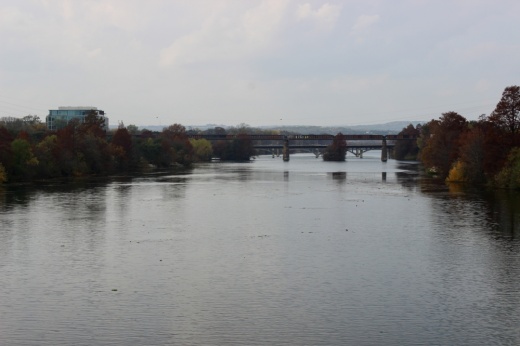What's happening
Officials will vote Nov. 18 to amend the Water Forward plan, the city's long-range blueprint for sustainable water use and management adopted in late 2018. Efforts to modernize the plan based on new analysis and community input have been in the works over the last few years.
Alongside that water-use roadmap, council will also consider changes to Austin's Water Conservation Plan and Drought Contingency Plan after additional public review since recent votes this spring.
The updates partly come in response to concerns over Austin's future access to drinking water, sourced from the Highland Lakes that have seen lower capacity in the past few years following prolonged drought in the 2000s-2010s. Lakes Travis and Buchanan together are currently just over half full, according to the Lower Colorado River Authority.
Austin is also projected to see longer, worse droughts in the decades ahead as Texas grows drier overall. Those trends would come alongside a surge in demand, with Austin Water's customer base estimated to triple over the next 100 years.
Zooming in
Austin Water Director Shay Ralls Roalson said the Water Forward update is focused on the conservation and reuse of the city's water from along the Colorado River. The utility is also planning for alternative sources given reliance on the river and lakes, she said, as well as partnerships with other communities reliant on the Highland Lakes and entities like the LCRA.
One notable change in AW's process for the new version of Water Forward accounts for the uncertainty of future conditions, Roalson said.
The update follows new climate and hydrology projections. Instead of accounting for only a single most likely outcome down the road, Roalson said the utility modeled a wide range of different water resource mixes under various anticipated future conditions—and will continue to do so.

Based on that work, AW proposed various improvements to water loss strategies on its end and ways for customers to limit their own water use. New city rules about landscaping, incentives for efficient irrigation, and water reuse and reclamation are also recommended.
Additionally, AW is looking for alternative drinking water sources outside the Colorado River.
Options like the long-term storage of water in underground aquifers and using Lake Walter E. Long as a reservoir are being considered. By the late 2000s, the utility could also look to desalination, or converting salty groundwater into drinking water.

New strategies for conservation and both drinking and nonpotable water are estimated at billions of dollars combined. Even after recent utility rate increases, Roalson said Water Forward will still require "significant investment" from local customers and that AW is working to balance cost impacts.
“We want to keep equity and affordability top of mind as we develop these strategies, make sure we have a plan for a future that is fair and affordable to all of our customers," she said.
Also of note
The Water Conservation Plan and Drought Contingency Plan adopted this spring are also back for revision after another look from the community this summer.
On conservation, changes are aimed at measuring current conservation work and goals for residents, commercial customers and the utility overall.
“We don’t have strategies to fully meet [those goals], but we have a really good foundation, and we know we can get there when we commit the resources to do that," Roalson said.
To respond to drought, new restrictions for drip irrigation systems intended to limit water use are also on the table. That follows recent changes to AW's capacity benchmarks for the Highland Lakes that trigger different stages of drought, and related watering restrictions for customers.





